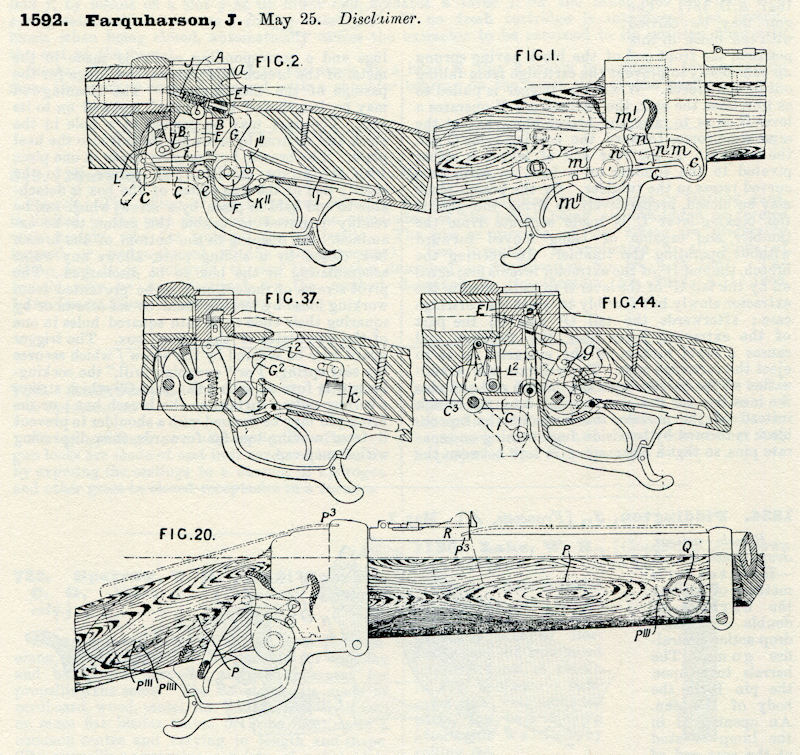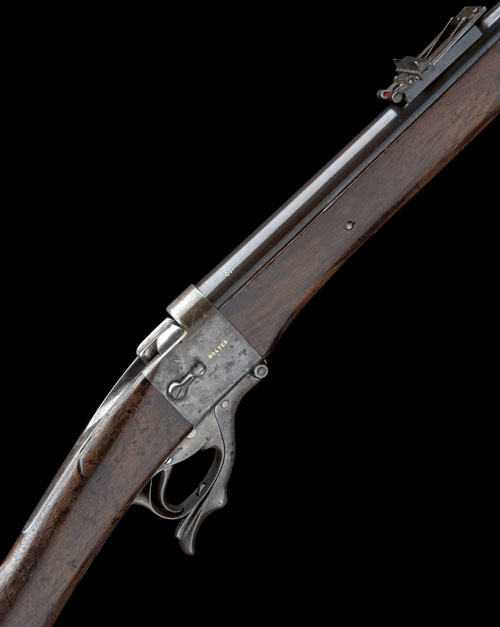You are here: Home > Firearms > Gunmakers > George Gibbs

The following description of the Farquharson breech is from a series of articles published in 1882 on ‘The Military Rifle And Its Development’, this part of the series discusses the then ‘Modern Breechloaders’.
The Farquharson breech, which is attached to the Metford rifle as manufactured Mr. Geo. Gibbs, of Bristol, is one of the oldest actions we have among the rifles of the present day. The inventor – Mr John Farquharson – is a Scotchman, and formerly lived at Blairgowrie – and we remember having seen him at Irvine, in 1871, exhibiting the action, which was then fitted to a Henry barrel. Mr Farquharson approached several Governments with the view of getting his invention adopted, but it was just a little too late. Nearly all of them had selected a breech action shortly before, and they were therefore unwilling to re-open the question and incur additional expense before giving the newly chosen weapon a fair trial. Ultimately the action was purchased by Mr Gibbs, who proceeded to perfect it and protect it by letters patent under the Great Seal. In this endeavour he was met by Mr Henry, of Edinburgh, who contended that Mr Farquharson was not the original inventor, that it was founded on and was infringement of patents by Mr Henry, and that Mr Farquharson had made use of information confidentially imparted to him or obtained during visits he was permitted to make to Mr Henry’s manufactory. It is not necessary to go further into this dispute than to say that the Lord Chancellor, before whom the case was debated, decided in favour of Mr Farquharson. This breech block was the first in which the principle of the concealed hammer was introduced. It consists of a vertical sliding block, lowered by an underlever. The lock has the old a gun spring and swivel attached to the tumbler. The spring drives an internal hammer on to a striker held by and passing through the breech block. The hammer is cocked by a bar, one end being attached loosely to the main lever and the other end fitting into a notch in the breast of the hammer, which is begun to be lifted just before the breech block is pulled down by the main lever. This is accomplished by the use of the slotted link, and the striker is at liberty to be pushed back by the slightest down movement of the block, so that it is impossible for the striker to hitch in the cartridge or be in the way. An extractor of great power is fitted to the action, so as to ensure the speedy exit of the fired case from the chamber. The calibre of the barrel is .461, has seven grooves, and the spiral is what is known as increasing, being sharper at the muzzle than at the breech. It takes a solid drawn brass cartridge containing 75 grains of powder and a bullet of 480 grains in weight.
Source: Glasgow Herald, Scotland, Thursday 6 July 1882
John Farquharson’s had two patents for his ‘breech block’, the first No. 3178 of 1870 and the second No. 1592 of 1872. Illustrated below are drawings from the 1872 patent abridgment.
In 1875 Farquharson’s patent of 1872 was reassigned to John Farquharson, George Gibbs, Thomas Pitt and William Ellis Metford.
The patent was also registered with the US Patent Office in 1877 and a version of this is available on line [pdf].

The patent dispute between Alexander Henry and John Farquharson referred to in the above article was reported upon in The Scotsman of Monday 23 December 1872:
BREECH-LOADING PATENT –
ACTION BY SCOTCH PATENTEESIN the London Court of Chancery on Saturday two petitions – one by Mr Alexander Henry , of Edinburgh and another by Mr John Farquharson, of Blairgowrie in the county of Perth – were heard before the Lord Chancellor for his decision as to which of the two was entitled to a patent which had been applied for by them for improvements in breech-loading arms, for the purpose of rendering the piece self-cocking and for combining in one motion the throwing open the cartridge chamber and the extraction of the spent cartridge-case and cocking the tumbler. Mr Henry, the well-known manufacturer of breechloading rifles, had obtained a patent in 1869, and a farther patent for improvements m 1870. It was stated that another improvement had been invented by Mr Henry in 1871, a sketch of which was shown to one of his workmen, and for this improvement he presented a petition for a patent in August last. At the same time the-usual declaration and complete specifications were left at the office describing the nature of the invention. On the 24th of September objections were lodged, to this application on behalf of Mr Farquharson, who had applied in May last for letters-patent for improvements in breech-loading firearms, accompanied also by specifications, Mr Henry objected to Mr Farqubarson’s application, on the ground that the latter was not the first and true inventor, and that his application was made in fraud of his (Mr Henry’s) rights, and that the invention was the same in all respects as the invention for which Mr Henry had obtained a patent in 1869, and in pursuance of which breech-loading firearms had been made and sold previously to May last year. When these conflicting claims came to be discussed before the Solicitor-General in November last, he declined to adjudicate upon them, and consequently the present application was made to obtain the decision of the Lord Chancellor. The evidence was of a very conflicting nature. On behalf of Mr Henry it was alleged that Mr Farquharson, who was a gamekeeper, had obtained information about his intended application from one of Mr Henry’s men, and had been allowed access to Mr Henry’s manufactory and shooting grounds at Edinburgh, where the different kinds of firearms were fully explained to him. On the other hand, it was alleged by Mr Farquharson that he was the first inventor, and that Mr Henry had obtained information about his improvement from a man to whom he had shown a sketch, and also from its having seen, publicly used and explained at the Wimbledon meeting in July last.
HIS LORDSHIP, after considering the evidence on both sides, decided upon refusing the application of Mr Henry and granting that of Mr Farquharson.
Pictured is
a .461 Farquharson
patent falling-block military
breech loading rifle by
George Gibbs of Bristol.
It has a 33in Metford barrel.
This rifle was sold by
Holt’s of London, June 2011.

See: John Farquharson